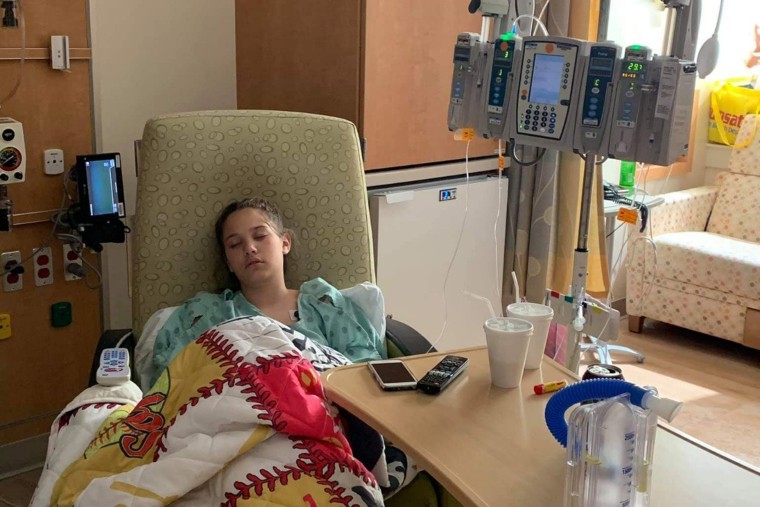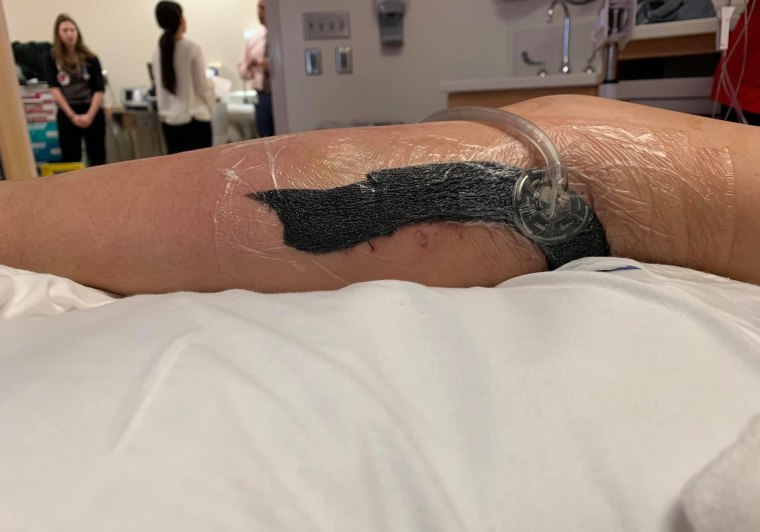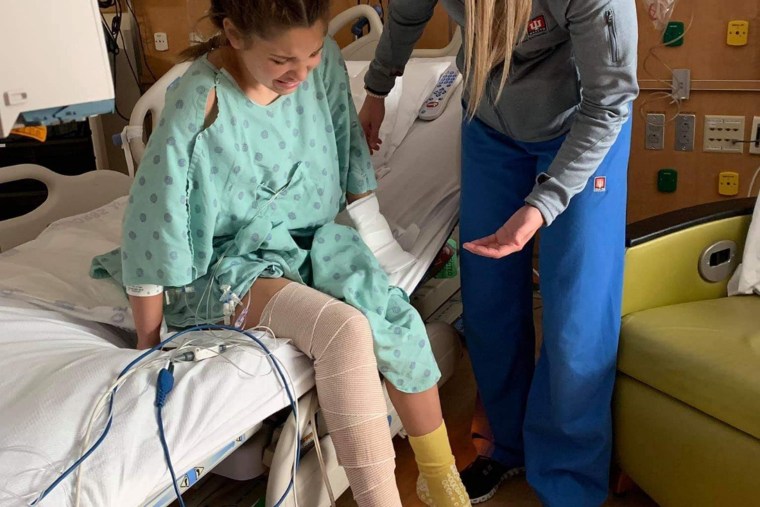Countless families head to beaches along the East Coast this time of year for a little rest and relaxation. But one mom wants other parents to know that there's a hidden danger in the waters: Kylei Parker, 12, is currently recovering from necrotizing fasciitis, a flesh-eating bacteria, that sent her to the intensive care unit after a family vacation.
Kylei Parker and her family went on a road trip from Mooresville, Indiana to Destin, Florida, earlier this month, where they had a fun and relaxing trip. That all changed during the ride home to Indiana when the girl complained of excruciating pain in her leg — to the point where she couldn't even walk.
"We made it to Alabama and stopped to eat and she was in a great deal of pain," her mom, Michelle Brown, told TODAY. "I was having to carry her on my back."

That's when Brown decided to call her daughter's pediatrician. She made an appointment for the next morning. By the time the family arrived home, Kylei had a fever, swollen leg and a red rash was spreading.
At first, her mother suspected it was a blood clot or a pulled muscle.
"Any movement of her leg had her in tears," said Brown.
It wasn't until Kylei's pediatrician saw her that they realized just how serious her condition was. Instead of sending her to a hospital across the street, the doctor told Brown to go home, pack clothes and take Kylei to Riley Hospital for Children in Indianapolis, which specializes in children's health.
"I was pretty calm until they told me that and then my anxiety level went from a zero to 110," said Brown. "I was panicking, but trying to not let Kylei see me panicking."

What is necrotizing fasciitis?
At the hospital, doctors determined Kylei had contracted necrotizing fasciitis, a rare bacterial infection that enters the body through a break in the skin or blunt trauma, and then aggressively attacks tissue. The flesh-eating bacteria kills one in three people, according to the Centers for Disease Control and Prevention.
Recognizing the symptoms early can help survival rates: accurate diagnosis, rapid antibiotic treatment and prompt surgery are crucial to stopping the infection. Though the CDC notes that symptoms can be confusing and tend to develop quickly. Here is what to look out for:
- A red or swollen area of skin that spreads quickly
- Severe pain
- Fever
Later symptoms can include:
- Ulcers, blisters or black spots on skin
- Pus from the infected area
- Dizziness
- Exhaustion
- Diarrhea or nausea
Parker had all of the early symptoms. Her mother believes the bacteria entered her body through a scrape she had on her toe from playing on a skateboard before vacation. In Florida, she played in the water at the beach, which is how doctors believe she likely contracted the bacteria. TODAY has reached out to Riley Hospital for Children for more detail.
While necrotizing fasciitis is rare, a recent report found that this bacteria could be spreading along the East Coast due to rising ocean temperatures from climate change. While anyone can get it, people with other health issues like diabetes, cancer, kidney disease or cirrhosis may be more at risk. The CDC recommends people with open wounds avoid swimming in natural bodies of water, pools and hot tubs.
A long road to recovery
At Riley Hospital, Kylei was admitted to the ICU, where doctors and nurses pumped her with IV fluids in an effort to stop her blood pressure from dropping any lower. After discovering a pocket of infection behind her knee, doctors conducted an MRI to confirm that the infection was rapidly attacking the 12-year-old's body. To make matters worse, she was also in septic shock. Sepsis, shock and organ failure are common complications of necrotizing fasciitis.

Kylei was rushed into surgery in an effort to save her life and prevent doctors from having to amputate her leg. Over the next few days, she had two more surgeries to remove the infection.
After spending a week in the hospital, she is now resting at home. Her leg is stitched up, in bandages and she has an IV port in her arm. Her lab results are normal, but she will need physical therapy to regain her ability to walk.
Before her daughter's experience, Brown said she had never heard of necrotizing fasciitis. She's now on a mission to make sure everyone knows the symptoms, since they can often be mistaken for other conditions. Prompt medical attention is crucial to saving a life and limbs.
There aren't vaccines to prevent group A strep infections, which include necrotizing fasciitis, so the best defense is knowing the symptoms and avoiding swimming with an open wound, according to the CDC.
"We learned as we were living it," said Brown. "I don’t want people to think we’re sharing for attention. We are sharing because this is so critical and so many people don’t know about this. Once you start experiencing the symptoms, it’s already running rampant in your body."
